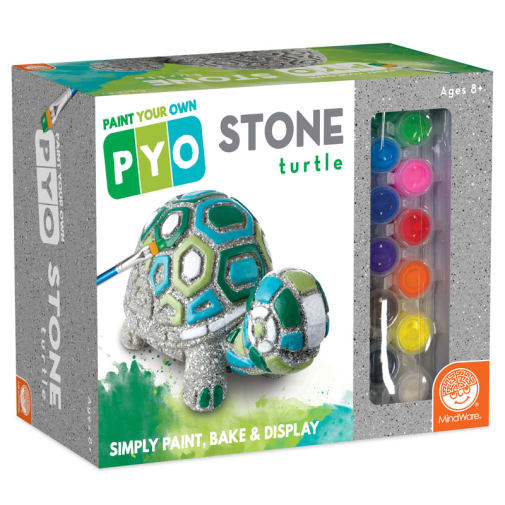This adorable little stone turtle just needs your creative touch! Use the included 12 paints and paintbrush to add vibrant color to the detailed mosaic on his shell. Recommended for grades 3 and up. Measures 8” x 4”.
Paint Your Own Stone: Turtle
SKU
010870
Grade 3-AD
These icons are designed to help you quickly understand and learn important information about our products.
Teaching Method
Traditional
Teacher-centered curriculum commonly used in classrooms that may include a text, teacher manual, tests, etc.
Charlotte Mason
A methodology based on the work of a 19th century educator who maintained that children learn best from literature (Living Books), not textbooks.
Classical
A methodology based on the Latin Trivium (three stages of learning), including the grammar stage (memorization and facts), logic stage (critical thinking), and rhetoric stage (developing/defending ideas).
Unit Study
A thematic or topical approach centered around one topic that integrates multiple subject areas.
Montessori (Discovery)
A methodology based on the work of a 20th century educator that emphasizes student and sensory-driven discovery learning and real-life applications.
Other
Other methodologies
Religious Content
Secular
Contains content contrary to common Christian beliefs (i.e. evolution).
Neutral
Avoids religious or theoretical topics or presents multiple viewpoints without preference.
Christian/Religious
Faith-based or including instructional religious content.
Learning Modality
Auditory
Learns through listening, talking out loud or reading out loud.
Visual
Learns through seeing, prefers written instructions and visual materials.
Kinesthetic/Tactile (Hands-On)
Learns through moving, doing and touching.
Multi-Sensory
Curriculum that employ a variety of activities/components.
Presentation
Sequential
Curriculum progresses through well-defined learning objectives. Emphasizes mastery before moving to the next topic.
Spiral
Topics and concepts are repeated from level to level, adding more depth at each pass and connecting with review.
Conceptual/Topical
Focus is on the “why,” often with a unifying concept as well as specific skills; coverage may be broader.
Teacher Involvement
Low Teacher Involvement
Student-led materials; parent acts as a facilitator.
Medium Teacher Involvement
A mix of teacher-led time and independent student work.
High Teacher Involvement
Teacher-led lessons; may utilize discussions, hands-on activities and working together.
Additional Materials Required
No other materials needed
Everything you need is included.
Other Materials Required
There are additional required resources that are a separate purchase.
Other Materials Optional
There are additional resources mentioned or recommended but are not absolutely necessary.
Consumable
Consumable
Designed to be written in; not reusable.
Non-Consumable
Not designed to be written in; reusable.
Our Price
$21.95 Product Overview
- Adorable stone turtle just needs your creative touch
- Use the 12 included paints and paintbrush to add color to his mosaic shell
- When done, let dry for 24 hours, then bake for 30 minutes for a weather-resistant finish
- Includes a printable color planning template
Description
Publisher's Description of Paint Your Own Stone: Turtle
No cement mixing or messy prep work is required; this 8" x 4" stone Mosaic Turtle is ready to paint, right out of the box. Vibrant paints encourage mixing, blending and special effects. Oven-bake your painted creation for a long-lasting, weather-resistant finish. • Decorate your outdoor living space with this inspiring, simple craft• Develops creativity, hand-eye coordination and color mixing skills• Includes 8" x 4" stone turtle, 12 pearlescent paints, paint brush and instructions• Printable color planning template.
Details
| Product Format: | Other |
|---|---|
| Grades: | 3-AD |
| Brand: | MindWare |
| EAN/UPC: | 192073341965 |
| Length in Inches: | 7.75 |
| Width in Inches: | 10.125 |
| Height in Inches: | 5.125 |
| Weight in Pounds: | 3.05 |
Videos
Reviews

